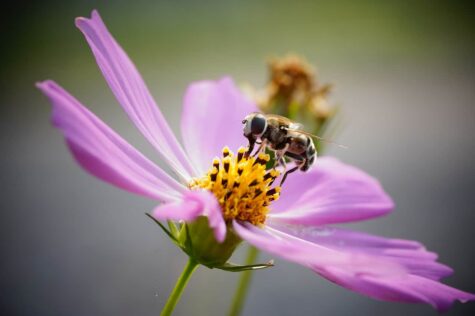As summer turns to autumn, we add layers and shiver whereas plant leaves are conditioned by the daylight and the temperature.
Green leaves start to turn yellow, then orange and red, painting a fabulous fiery tint to leaf foliage. Mother Nature’s canvas illuminated!

Photo by Evie Fjord on Unsplash
Here are 14 of my favourite autumn flowering climbers with bright red leaves plants and a recipe that you can make from one of them.
1. Virginia creeper: Boston ivy

Image credit: @harvestcootamundra
When we think of a whole house covered in red leaves, the first name that springs to mind is Virginia creeper. There are actually two types of Virginia creeper; the first is a type of ivy.
Boston ivy climbs wonderfully over the frontage of buildings and delights passers-by with its gorgeous colours in autumn. Despite its fabulous appearance, it can be invasive so be careful to prune it regularly to enjoy it where you want it.
2. Virginia creeper: Parthenocissus quinquefolia

One of the most striking red autumn plants. Image credit: @manuelcover_gardendesign
This vigorous climbing plant is much-admired in autumn for its vibrant display of leaf colour. It’s an enthusiastic rambler so make sure you prune it back annually.
Its pointed leaves are often seen in children’s leaf collages and prints and understandably so. A super pretty climber, it needs a sunny position to thrive.
3. Firethorn (Pyracantha)

Image credit: @when_color_matters
In spring Firethorn offers bees a mass of white flowers with a delicious scent but you need to watch out for the thorns that give this plant its name!
In the autumn, it becomes every gardener’s delight, as the large volume of berries on its stems turn a vivid orange-red. Many gardeners like to train firethorn on a series of wires to keep it manageable. Prune it well in spring to keep its shape.
4. Chinese witch hazel

Image credit: @davesplot22
This plant is grown in Asia where it is also known as Loropetalum Chinensis. Witch hazel will grow really strongly, climbing to fill a huge space in no time.
It has divine pinky-red flowers and the foliage appears like a curtain of colour in the autumn. Draped over a shed, a wall or the front of your house, Chinese witch hazel will be admired by all who are lucky enough to see it.
5. Barberry (Berberis thunbergia)

Image credit:@westwoodgardens
The Japanese barberry, thunbergia is quite a compact plant but if you are looking for red tones for an autumn show, this is one you definitely need. This could be positioned in front of a taller, scarlet leaved plant to add foreground interest.
The leaves begin as a bright red which fade slightly as the season progresses so that by the autumn, you have two-toned leaf foliage.
6. Crab apple

Image credit: @neongardenstudio
Although strictly speaking this is more of a tree than a climber, many gardeners espalier the branches of crab apples to be able to reach the fruit. The branches climb horizontally along the wires, producing bunches of flowers, leaves and fruit in abundance.
By autumn, this gorgeous shrub is covered in a plentiful supply of small red fruits and the leaves also take on an autumnal pink tinge. What’s not to like? You can make delicious crab apple jelly if you boil the fruit with sugar.
7. Purple leaf grapevine

Grapevines climb any support you provide and give you edible leaves as well as grapes for eating or making wine. However, this variety offers a dash of colour in your autumnal garden too.
You are guaranteed all shades of colour from red through to purple from this plant and as the leaves die off, gather them to make leaf mould by placing them into a bag to use in planting next spring.
8. Dwarf French bean – Purple Queen

Image credit: @my.rookie.allotment
Most vegetable gardeners will recognise the name as the twisting, curling bean plant which produces fabulous purple blooms, which become hanging purple beans in summer.
Known as one of the best-flavoured beans you can grow, their leaves also take on an amazing red shade in autumn, so it is worth leaving these plants on their support until the snow arrives.
9. Euonymous alatus

Image credit: @flowerstory13
This plant is also known as “burning bush” which is the colour it takes in autumn. Even from a distance, this shrub will spread a wave of warm red all over your garden. It is also beautiful in spring but it really shines in autumn.
The branches can be tied onto any support you want it to grow on and my advice is to place it where you can admire it from your favourite chair in winter.
You Might Also Like: 15 Smart Ways to Use a Trellis in Your Garden
10. Rosehip bush

Image credit: @the_little_end_cottage
Rose hips are a familiar sight in the British countryside in winter and indeed, part of our heritage from World War II when children were sent to gather handfuls to make vitamin C-rich rosehip syrup. The reason I have included them is for the cheerful colour of the hips you see as you walk in any rural environment.
Roses can be trained to grow on supports and I like to cut mine back quite sharply so that they don’t become too leggy. However, if you have the space in your garden, you could grow two climbing roses up a pergola or arch. Then you (along with the bees) can enjoy the summer blooms and enjoy a plentiful supply of rose hips later in the year. If you would like to make your own rose hip syrup, see my recipe below.
11. Fuschia

Image credit: @marg_in_pictures
Depending on where you live in the UK, climbing fuschias provide another attractive splash of red in your autumn garden.
They are quite frost-tolerant plants and they’ll keep flowering until the frosty air decorates their flowers and leaves with a layer of white. Grown as a climber, you can admire plenty of bee visitors throughout the summer too.
12. Photinia x fraseri Red Robin

Add seasonal colour with a red robin. Image credit: @viversbarri
The new leaves of Photinia red robin are a glorious shade of red. Whilst the leaves will eventually become green, you can encourage new growth by regularly removing the tips of young shoots. You can prune photinia up to 3 times a year during its growing season from March to September.
13. Red cobnut

Image credit: @ecologicalenglish
This plant is a miracle in every season! It is a type of hazelnut and in late winter and early spring you will notice yellow hanging catkins, which are followed by delicately shaped leaves. By the summer your plant will be climbing for the light and expanding in all directions.
In the autumn, you will find handfuls of scarlet hazelnuts ready for eating, and the leaves turn to a fiery shade of red which changes gradually to purple as the season progresses. One of my favourite trees!
You must prune the cobnut back hard each spring to keep its shape and if you love it as much as I do, transplant one of the many offsets at the base, by digging up the roots and re-potting it. This is a great, unusual Christmas present for any gardeners you know.
14. Dogwood

Image credit: @ornamentaltreesltd
A worthy plant for a colourful autumn garden display, the red branches of dogwood can often be seen in winter hedgerows.
These plants flower beautifully in spring and summer but in autumn, it seems a magical painter has been at work on its stems and branches. Just as the first frost arrives, the bright scarlet can be seen and if you plant several close together, it will create a wonderful glow of colour in any garden.
Dogwoods will climb to reach the sky so prune them into shape in spring.
Tina’s Rose hip Syrup recipe:

A spoonful a day keeps the doctor away. Image credit: @adam.cawley
- You will need to pick two generous handfuls of rose hips after the first frosts. The first frost is said to sweeten them.
- Top and tail the black parts from the top and bottom of the hips with a knife.
- Boil 2 cups of water in a saucepan as you get the rose hips ready. (You can add extra water if you think the consistency is too thick after cooking the rosehips).
- Fill a cup with rose hips and empty this into a saucepan. Add a second cup of rose hips and stir them into the water to cook gently.
- Bring the mixture almost to the boil, but not completely. You want to soften the hips not destroy all that valuable vitamin C. Allow the mixture to simmer for 10-15 minutes to allow the hips to soften.
- Next, you need to remove the black hairs, which are an irritant to our throats so prepare 2 squares of muslin to strain the mixture through. You can use any cloth like a dishcloth or old, recycled fabric from clothes works well too.
- Strain the mixture from the saucepan to a bowl and discard the hairs and seeds left in the muslin.
- Strain the mixture again through a different piece of cloth, because it is important to remove the hairs completely. Discard the second strained seeds and hair and then pour the mixture back into the saucepan.
- Add a cup of sugar and bring it back almost to the boil, stirring continuously. By now you can smell the distinctive syrup and you will want to taste it to make sure that the sugar is dissolved.
- Finally allow the syrup to cool and sterilise some recycled jars by washing them, then allowing them to dry in a hot oven for a few minutes. Fill the jars with syrup and seal them.
Enjoy a spoonful of the syrup as a tonic to keep colds and flu at bay or it’s delicious mixed with gin or vodka. I’ve also had this syrup on ice cream and it’s is a great way to get vitamin C into reluctant fruit or vegetable eaters of your family.
It won’t keep long but store it in your fridge after you open the jar. Unopened jars should keep for about 3 months so pick plenty of rosehips when you see them and store them in your freezer until you need them.

Save this pin for later






